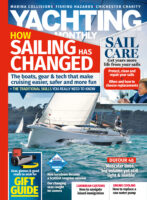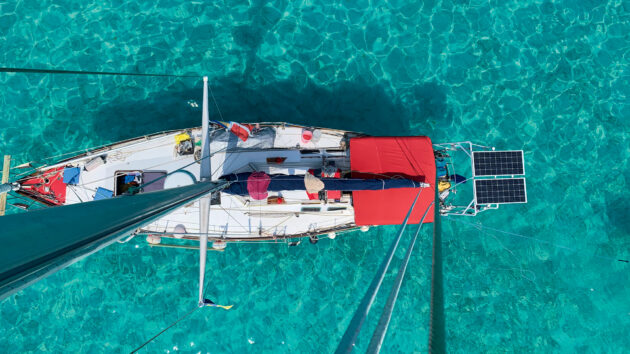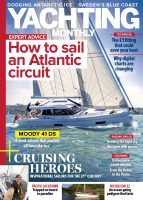Paul Trammell sails his Cartwright 40 Windflower singlehanded. Here he explains why you don't need an anchor windlass
My first sailing boat didn’t have a windlass, and this led to a bit of unexpected drama. I was sailing in the Bahamas in my 30ft Dufour Arpege when I came across beautiful waves at Egg Reef. At the time, I was writing the book Journey to the Ragged Islands, and I was actively seeking adventure to write about.
Before me was an opportunity to surf on a reef two miles offshore in perfect conditions with nobody out. I had to do it.
The depth dropped off steeply outside the breaking waves, and I lowered my new anchor in 20m of water and let out all the scope I had – 15m of 8mm chain followed by 60m of 3-strand nylon rope. I paddled out and surfed in the clear water with coral reef visible below, achieving one of my sailing goals.
I made the dream come true, but ended up with more adventure to write about than I had anticipated. As the sun crept closer to the horizon, I sat down at the bow to pull up the 12kg anchor.
I pulled up the rope until I was directly above the anchor, and could pull no more. It wouldn’t budge. I tried driving the boat forward, clockwise and counterclockwise to free the anchor, but to no avail. Convinced it was stuck, I got out my mask, snorkel and fins. I sat down and looked out at the beginning of the warm sunset over the blue Atlantic Ocean to calm my mind and slow my heartrate.
Freediving is one of my passions, so I was able to dive to the anchor, where it sat in a hole in the rocky bottom. I wrestled it out of the hole and swam for the surface. Back on deck, I sat down and pulled on the rope with confidence, but still couldn’t lift the anchor.

Freediving down to 20m is beyond most of us, even if the water was this clear and warm
I dove three more times. On the third dive, I brought a line to tie to the tripping point, but the line didn’t reach the bottom. On the fourth dive, with the line extended, I saw that the anchor was hanging 5ft above the bottom. It was free!
Back on deck, I sat down to pull up the anchor with a smile on my face. It still didn’t budge. I laughed as I realised that the anchor was never stuck, I was simply not strong enough to pull it up with the added weight of all the chain. In my defence, the anchor roller was frozen and didn’t roll. Most of the anchorages in the Bahamas are in shallow water, so I had not yet pulled the anchor from a depth greater than 5m.
At this point, the sun was dipping below the horizon and we were drifting with the anchor hanging 20m down. I thought to myself, ‘What would Bernard Moitessier do?’ An idea quickly came to me and I put the rope on the mast winch and cranked until the chain reached the winch. At that point, with another 3m of chain out of the water, I was able to pull the anchor up.

In deep water, hauling in all that chain as well as the anchor can be back-breaking work
Tripping along
After this experience (and before I came up with the block and tackle solution) whenever I anchored in deep water, I tied a trip line to the tripping point of the anchor. The tripping point is the little hole on the back of the anchor’s fluke. It is there so you can lift the anchor out backwards, in case it is stuck on the bottom. Not only does lifting from the tripping point help free a stuck anchor, it also allows you to lift just the weight of the anchor without all the chain.
To set up a tripping line, select a line longer than the depth of the water, tie one end to the tripping point of the anchor, and the other end to a float (like a fender). When lowering the anchor, keep enough tension on the tripping line so that it doesn’t get twisted around the anchor as it descends. To lift the anchor from deep water without a windlass, you can pull the anchor up with the tripping line, about 3m, then cleat it off, pull up the slack in the chain, and repeat.

If your anchor fouls on rocks, a trip line is much easier than diving down to it
This way, the most weight you are lifting is that of the anchor plus 3m of chain. It helps to run the tripping line through a block hanging from the bow pulpit or a second bow roller if you have a double roller, then pull it up while sitting down and leaning back.
A tripping line is useful for freeing the anchor from a snag, lifting it without a windlass, or retrieving the anchor from the dinghy, which I do when I use a stern anchor. It’s also possible to lift the anchor with a winch in the cockpit or on the mast, but I find this messy and inefficient.
Also, you might find you need to use two lines with chain hooks, since winches don’t work well with chain.
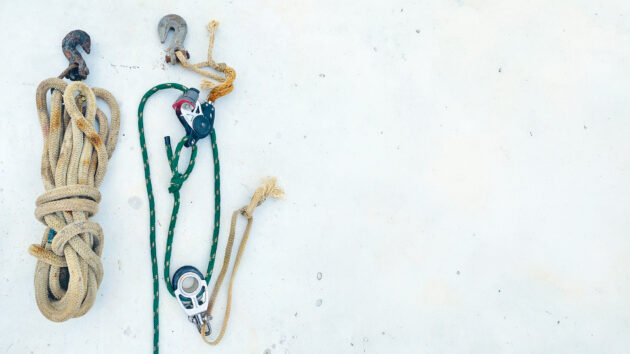
All you need to set this up is a 3:1 block and tackle (two single blocks, one of which has a becket), two chain hooks, and some line. A becket is an attachment point for a line on top of the block, opposite where a shackle would normally go. The operation is easier if your block with the becket also has a cam cleat, but this is not absolutely necessary.
You might already have this setup as your mainsheet assembly, boom vang or on a running backstay. Of course, you could use a 2:1, or a 4:1, or whatever mechanical advantage works for you. To set up the 3:1 system, run the line first through the block with the becket, then through the other block, then tie the line to the becket on the first block.
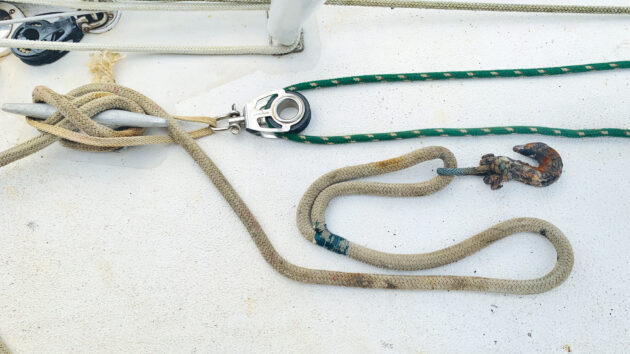
Tie one chain hook to a short line. I use my normal snubber for this, since it is simply a chain hook on 8m of line. Hitch this to a midship cleat, leaving about 2m of line behind the chain hook-free.
Fix your block and tackle to the same midship cleat with a loop of line tied to the block without the becket.
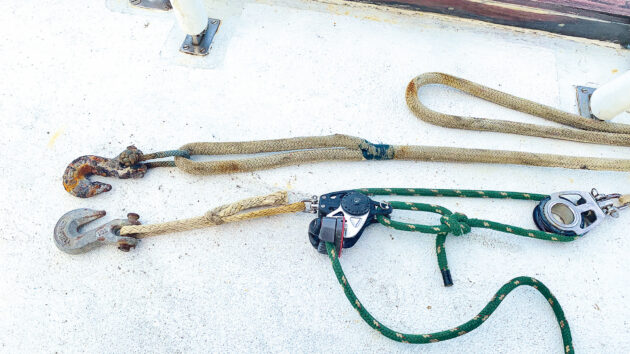
Tie another chain hook to the block with the becket (and cam cleat, if you have it), onto the shackle opposite the becket. Hook this chain hook to the anchor’s chain just aft of the bow roller. If you don’t have a chain hook, or if you are pulling up rope instead of chain, use a line and a rolling hitch instead.
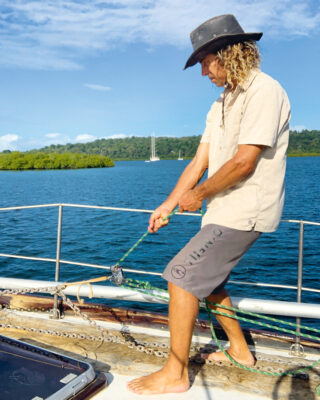
Before I start, I lay out an old canvas weather-cloth on the deck between the bow roller and the midship cleat. This is where all the chain is going to end up, and the canvas keeps the deck clean. A tarp of any sort would work, but again, this is not absolutely necessary.
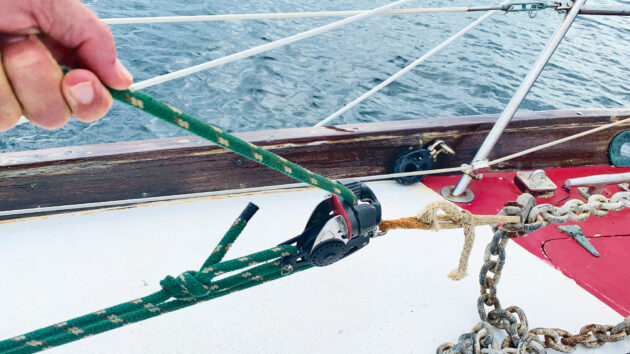
Once all this is set up, stand in front of the midship cleat and pull in the line that runs through the block & tackle. The chain will come up and lay on the tarp. When the first section of chain comes up, it will drag and equal amount of chain out of your chain locker. Make sure this is free to move.
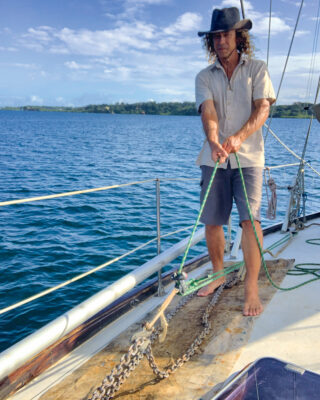
Once the chain is within reach of the hook on the short line (the one attached to the midship cleat), fix this hook to the chain. Let off tension on the block and tackle, and disconnect its chain hook. The chain hook fixed to the midship cleat now holds the weight of the chain and anchor. Take the chain hook on the block and tackle back to the bow and do it again.
The chain comes up a few metres at a time, and since you are working with a 3:1 mechanical advantage, it’s easy.
Keep repeating this process until the anchor is up and in place on the bow roller. Secure it properly.
Since I am singlehanded, I start the engine and motor forward just a bit, then put it in neutral and walk to the bow to begin hauling in the chain. I end up walking back to the cockpit a few times during the process, and I pay careful attention to where the boat is once the anchor is off the bottom. If it is too windy and the risk of drifting into other boats or shoals while lifting the anchor is too great, I don’t leave.
Don’t get me wrong, I have nothing against windlasses, and I’d love to have one. But I chose to spend my refit money on things I felt were more mission-critical. Even if you have a good windlass, the day will probably come when it fails, and you’ll hopefully remember this article and go hunting for two chain hooks, some line, and a 3:1 block and tackle. Happy sailing!
Enjoyed reading this?
A subscription to Yachting Monthly magazine costs around 40% less than the cover price, so you can save money compared to buying single issues.
Print and digital editions are available through Magazines Direct – where you can also find the latest deals.
YM is packed with information to help you get the most from your time on the water.
-
-
- Take your seamanship to the next level with tips, advice and skills from our experts
- Impartial in-depth reviews of the latest yachts and equipment
- Cruising guides to help you reach those dream destinations
-
Follow us on Facebook, Twitter and Instagram.
Note: We may earn a commission when you buy through links on our site, at no extra cost to you. This doesn’t affect our editorial independence.

